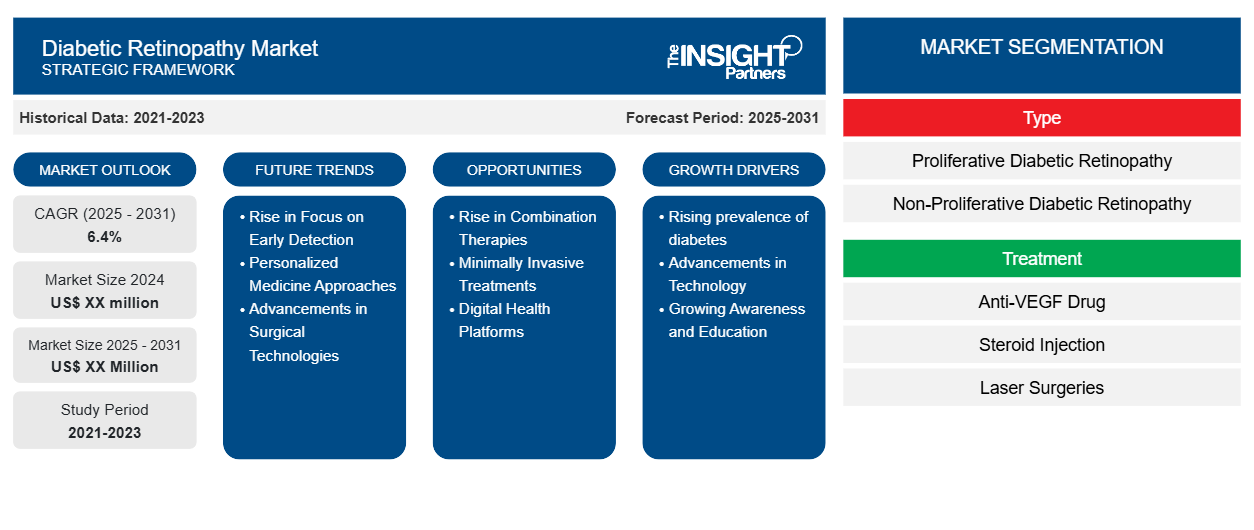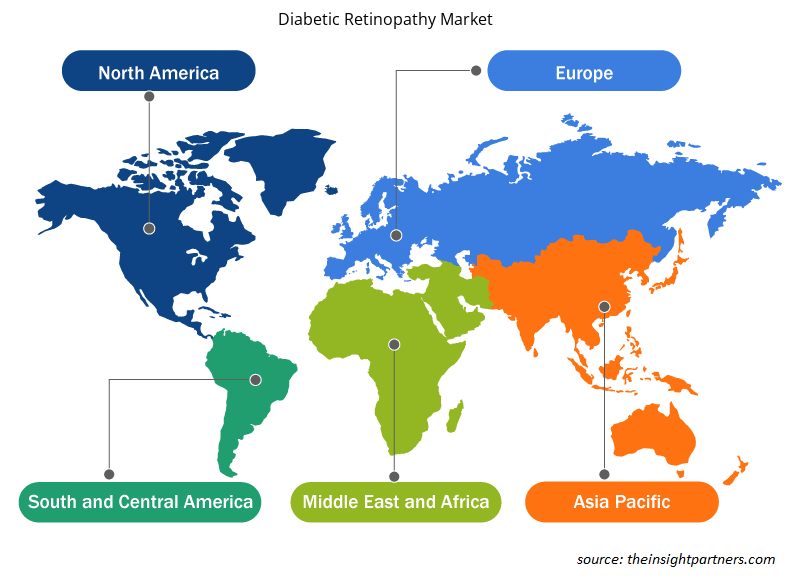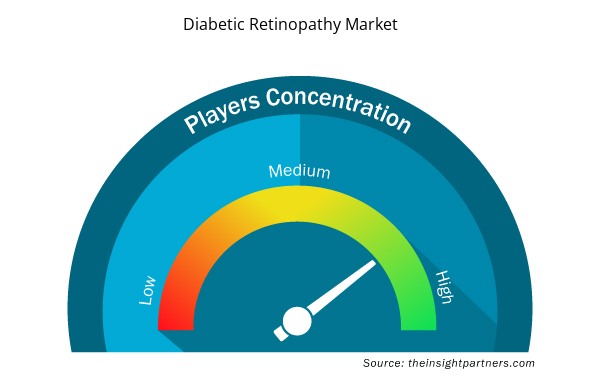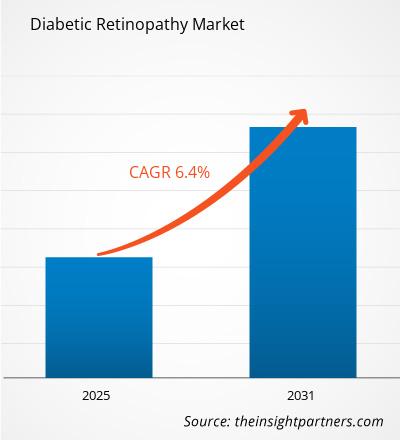The Diabetic Retinopathy Market is expected to register a CAGR of 6.4% from 2025 to 2031, with a market size expanding from US$ XX million in 2024 to US$ XX Million by 2031.
The report is segmented by Type (Proliferative Diabetic Retinopathy and Non-Proliferative Diabetic Retinopathy), Treatment (Anti-VEGF Drug, Steroid Injection, Laser Surgeries, and Vitrectomy). The report further presents analysis based on the Distribution Channel (Retail Pharmacies, Hospital Pharmacies, and Others). The global analysis is further broken-down at regional level and major countries. The Report Offers the Value in USD for the above analysis and segments.
Purpose of the Report
The report Diabetic Retinopathy Market by The Insight Partners aims to describe the present landscape and future growth, top driving factors, challenges, and opportunities. This will provide insights to various business stakeholders, such as:
- Technology Providers/Manufacturers: To understand the evolving market dynamics and know the potential growth opportunities, enabling them to make informed strategic decisions.
- Investors: To conduct a comprehensive trend analysis regarding the market growth rate, market financial projections, and opportunities that exist across the value chain.
- Regulatory bodies: To regulate policies and police activities in the market with the aim of minimizing abuse, preserving investor trust and confidence, and upholding the integrity and stability of the market.
Diabetic Retinopathy Market Segmentation
Type
- Proliferative Diabetic Retinopathy
- Non-Proliferative Diabetic Retinopathy
Treatment
- Anti-VEGF Drug
- Steroid Injection
- Laser Surgeries
- Vitrectomy
Customize This Report To Suit Your Requirement
You will get customization on any report - free of charge - including parts of this report, or country-level analysis, Excel Data pack, as well as avail great offers and discounts for start-ups & universities
Diabetic Retinopathy Market: Strategic Insights

- Get Top Key Market Trends of this report.This FREE sample will include data analysis, ranging from market trends to estimates and forecasts.
Diabetic Retinopathy Market Growth Drivers
- Rising prevalence of diabetes: According to International Diabetes Federation, an estimated 642 million people are expected to be suffering from diabetes worldwide by 2040, which drives up the demand for diabetic retinopathy treatments. The increasing number of prevalent cases of diabetes is one of the major growth drivers, as diabetic retinopathy usually results from complications of the disease.
- Advancements in Technology: Advances in technology such as artificial intelligence, machine learning, and others are going to enable development of increasingly more accurate and efficient diagnostic tools for diabetic retinopathy. Advances in treatment options for the patient: Advances in technology also improve the treatment options for the patient with diabetic retinopathy.
- Growing Awareness and Education: Growing awareness and education about all people regarding the need for regular eye examinations and early diagnosis of diabetic retinopathy are boosting demands for diabetic retinopathy treatments and services. American Diabetes Association suggests annual comprehensive eye examination by an eye doctor to patients suffering from diabetes. Presently, most health care services are actually trying to increase
Diabetic Retinopathy Market Future Trends
- Rise in Focus on Early Detection: The focus towards early detection of diabetic retinopathy has increased due to the high advancements in technology and much awareness about increased importance of early detection. Telemedicine and mobile health application are making remote monitoring and early detection of diabetic retinopathy possible. This further contributes to the better patient outcomes with lower healthcare costs.
- Personalized Medicine Approaches: Personalized medicine approaches, precision medicine is increasingly used for the treatment of diabetic retinopathy. Customized treatments based on the genetic makeup of the patient and the nature of their disease are being prescribed by different health care providers towards better patient outcomes and less treatment cost.
- Advancements in Surgical Technologies: Improved surgical technologies, for example microincisional surgery or femtosecond laser-assisted cataract surgery have the potential to improve the patient outcome and enhance recovery times. Developments such as these should spur market growth, not least because of savings and improvements in patient care flowing from them.
Diabetic Retinopathy Market Opportunities
- Rise in Combination Therapies: Involvement of combination therapies focused on several pathways involved in diabetic retinopathy is now opening new avenues in the treatment of the disease. Combination therapies are supposed to be more effective than single-agent therapies. This is likely to result in better patient outcomes along with lesser treatment costs.
- Minimally Invasive Treatments: Minimally invasive treatments, such as intravitreal injections and photocoagulation, are developing and opening fresh avenues in the treatment of diabetic retinopathy. Minimally invasive treatments are much more minimalistic than the classical surgical avenues, therefore starting with minimizing the risk to the patient and faster recovery times.
- Digital Health Platforms: Digital health platforms such as telemedicine and mobile health applications have facilitated the distant management of diabetic retinopathy. These platforms can optimize patient engagement and adherence to plans of care and therefore reduce healthcare costs and improve outcomes.
Diabetic Retinopathy Market Regional Insights
The regional trends and factors influencing the Diabetic Retinopathy Market throughout the forecast period have been thoroughly explained by the analysts at Insight Partners. This section also discusses Diabetic Retinopathy Market segments and geography across North America, Europe, Asia Pacific, Middle East and Africa, and South and Central America.

- Get the Regional Specific Data for Diabetic Retinopathy Market
Diabetic Retinopathy Market Report Scope
| Report Attribute | Details |
|---|---|
| Market size in 2024 | US$ XX million |
| Market Size by 2031 | US$ XX Million |
| Global CAGR (2025 - 2031) | 6.4% |
| Historical Data | 2021-2023 |
| Forecast period | 2025-2031 |
| Segments Covered |
By Type
|
| Regions and Countries Covered | North America
|
| Market leaders and key company profiles |
Diabetic Retinopathy Market Players Density: Understanding Its Impact on Business Dynamics
The Diabetic Retinopathy Market market is growing rapidly, driven by increasing end-user demand due to factors such as evolving consumer preferences, technological advancements, and greater awareness of the product's benefits. As demand rises, businesses are expanding their offerings, innovating to meet consumer needs, and capitalizing on emerging trends, which further fuels market growth.
Market players density refers to the distribution of firms or companies operating within a particular market or industry. It indicates how many competitors (market players) are present in a given market space relative to its size or total market value.
Major Companies operating in the Diabetic Retinopathy Market are:
- Abbott Laboratories
- Alimera Science
- Allergan Plc
- Ampio Pharmaceuticals
- Bayer AG
Disclaimer: The companies listed above are not ranked in any particular order.

- Get the Diabetic Retinopathy Market top key players overview
Key Selling Points
- Comprehensive Coverage: The report comprehensively covers the analysis of products, services, types, and end users of the Diabetic Retinopathy Market, providing a holistic landscape.
- Expert Analysis: The report is compiled based on the in-depth understanding of industry experts and analysts.
- Up-to-date Information: The report assures business relevance due to its coverage of recent information and data trends.
- Customization Options: This report can be customized to cater to specific client requirements and suit the business strategies aptly.
The research report on the Diabetic Retinopathy Market can, therefore, help spearhead the trail of decoding and understanding the industry scenario and growth prospects. Although there can be a few valid concerns, the overall benefits of this report tend to outweigh the disadvantages.
- Historical Analysis (2 Years), Base Year, Forecast (7 Years) with CAGR
- PEST and SWOT Analysis
- Market Size Value / Volume - Global, Regional, Country
- Industry and Competitive Landscape
- Excel Dataset


- Europe Surety Market
- Radiopharmaceuticals Market
- Advanced Planning and Scheduling Software Market
- Visualization and 3D Rendering Software Market
- Employment Screening Services Market
- Diaper Packaging Machine Market
- Artificial Intelligence in Defense Market
- Nurse Call Systems Market
- Medical Enzyme Technology Market
- Molecular Diagnostics Market

Report Coverage
Revenue forecast, Company Analysis, Industry landscape, Growth factors, and Trends

Segment Covered
Type, Treatment, and Distribution Channel

Regional Scope
North America, Europe, Asia Pacific, Middle East & Africa, South & Central America

Country Scope
US, UK, Canada, Germany, France, Italy, Australia, Russia, China, Japan, South Korea, Saudi Arabia, Brazil, Argentina
Frequently Asked Questions
The diabetic retinopathy market is estimated to grow with a CAGR of 6.4% from 2023 to 2031
The diabetic retinopathy market majorly consists of players such as Abbott Laboratories, Alimera Science, Allergan Plc among others
Asia-Pacific region is likely to witness the fastest growth rate during the forecast period.
The market drivers include the increasing prevalence of diabetes and rising geriatric population, which are driving the diabetic retinopathy market
Personalised medicine is likely to remain the key trend during the forecast period.
North America dominated the diabetic retinopathy market in 2023
Trends and growth analysis reports related to Life Sciences : READ MORE..
The List of Companies
- Abbott Laboratories
- Alimera Science
- Allergan Plc
- Ampio Pharmaceuticals
- Bayer AG
- F. Hoffmann-LA Roche
- Novartis International AG
- PFIZER
- Regeneron Pharmaceuticals Inc
- Valeant Pharmaceutical

 Get Free Sample For
Get Free Sample For